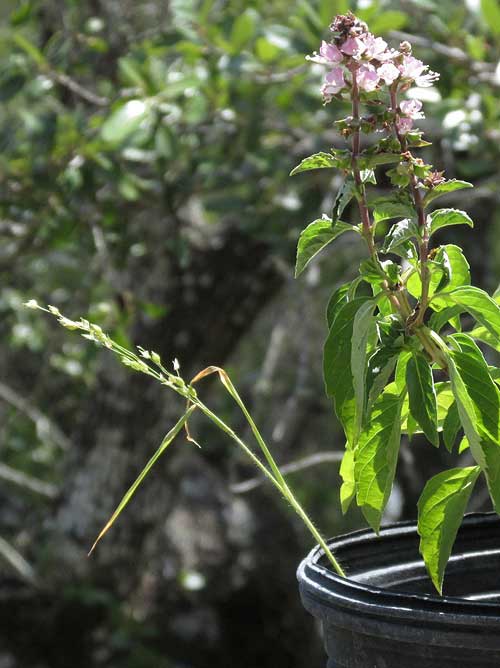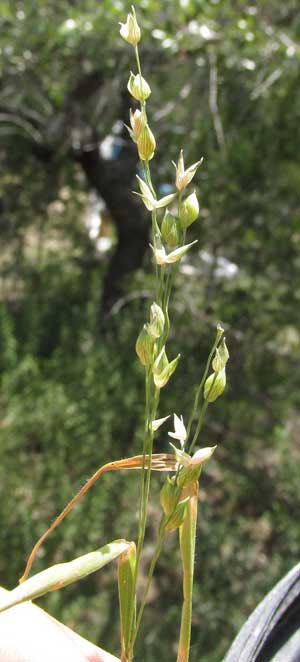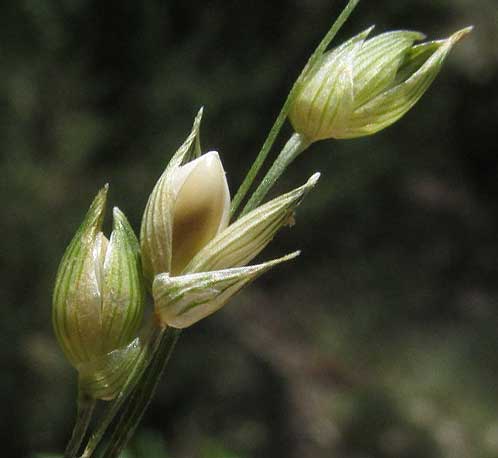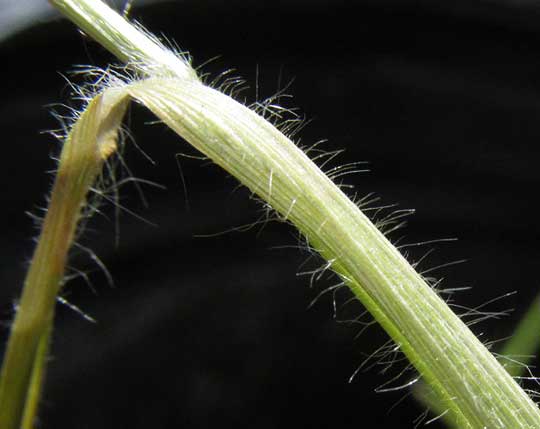Excerpts from Jim Conrad's
Naturalist Newsletter
from the August 17, 2014 Newsletter issued from the Frio Canyon Nature Education Center in the valley of the Dry Frio River in northern Uvalde County, southwestern Texas, on the southern border of the Edwards Plateau; elevation ~1750m (~5750 ft); N29.62°, W99.86°; USA
MILLET
A large-grained grass turned up in a pot of Basil, shown below:

A closer look at the flowering head, or inflorescence, is shown below:

For identification purposes, an important field mark seen in that picture is that the grass's spikelets arise at the ends of slender pedicels, which arise from branches of the inflorescence, which themselves branch from other inflorescence branches. In other words, this is a panicle-type inflorescence.
The somewhat-similar-looking Milo's flowering head also is a panicle, but Milo's flowers are much larger than these -- up to 9mm long (3/8ths inch), while these are only about half that long, 4.5mm long (3/16ths inch).
A close-up of individual flowers, or spikelets, with the middle spikelet exhibiting a mature, shiny, white grain, and with each spikelet appearing to be subtended by three substantial scales, or glumes, instead of the normal two, appears below:

The "three glumes" below each spikelet is important for identification purposes, and can contribute to confusion when "keying out" the grass using technical keys. In reality, each spikelet just has two glumes, as it's supposed to, but its "lemma" -- which in a "normal" grass floret is much less conspicuous and more closely enveloping the grain --in this genus looks like a "third glume."
Another sure indication that our Basil-pot grass is not just a stunted Milo is that the Milo plant's stem is hairless, while the Basil-pot grass's is long-hairy, as shown below:

From the beginning I suspected that our Basil-pot grass was Millet, since the bag the birdseed came in says it contains "White Millet, Milo, Wheat, Cracked Corn, Black Oil Sunflower." However, several grass species in entirely different genera are known as millets, and the seed bag's name "White Millet" also is a little ambiguous, so we still need to do some botany to be sure of which millet we have.
With the panicle-type inflorescence, with each spikelet containing just one fertile flower, and with spikelets being on long pedicles, our Basil-pot grass soon reveals itself as a member of the big, important grass genus Panicum.
Among the Panicums, of which maybe 30 or so occur in North America, our plant with its exceptionally large glumes, lemmas and grains soon reveals itself as PANICUM MILIACEUM, which is one of the several species known as millets. Besides being known as just plain Millet, it's also known by the names Common Millet, Proso Millet, Yellow Hog, Grain Millet, Broom Corn Millet, Hog Millet, and our seed-bag's White Millet. Among the various species known as millet, it's the third-most planted, the most popularly grown millet being Pearl Millet, Pennisetum glaucum. With such a proliferation of names for this single species, and these various names often shared with other species, one is especially glad for the binomial Panicum miliaceum.
Panicum miliaceum's wild ancestor lived in Eurasia and, as was the case with Milo, has been grown by humans for a long time ago. Its earliest domesticated remains have been excavated from sites occupied by humans about 7,000 years ago. These early sites occur in both the southern Caucasus Mountains and China, suggesting that the species may have been domesticated independently in each area. It's still extensively cultivated in India, Russia, Ukraine, the Middle East, Turkey and Romania. In the United States it's mainly grown for birdseed, but it's also sold as a health food. Due to its lack of gluten, it's marketed as a starchy food for those who can't tolerate wheat.
Our Basil-pot Millet is much smaller than Panicum miliaceum plants grown commercially, which normally reach about four feet high (1m), and whose heads may contain hundreds of whitish grains, instead of our plant's 15 or so. Our plant had to compete with a robust Basil plant. Still, despite its retarded growth, it displays very well all the distinguishing features of Panicum miliaceum.